Why Spanish Tapas Tours Are Spain’s Ultimate Cultural Experience
Spanish tapas tours offer the perfect gateway to understanding Spain’s soul through its food culture. These guided culinary trips take you beyond tourist restaurants into authentic local bars where Spaniards have gathered for centuries to share small plates, sip wine, and connect with their community.
Quick Guide to Spanish Tapas Tours:
- Duration: 2.5-4 hours on average
- Price Range: €55-€128 per person
- Group Size: Typically 10-20 people maximum
- What’s Included: Local guide, 10-12 tapas tastings, 4-5 drinks
- Best Cities: Madrid, Barcelona, Seville, San Sebastián
- Tour Types: Walking tours, private experiences, themed crawls
The word “tapa” literally means “cover” – these small dishes originated when bartenders placed bread and ham over drinks to keep flies away. Today, tapas culture is recognized by UNESCO as an Intangible Cultural Heritage, representing Spain’s approach to socializing, sharing, and savoring life’s simple pleasures.
Modern tapas tours blend this rich history with practical exploration. You’ll hop between 4-5 traditional bars, learning local ordering customs while sampling everything from jamón ibérico to gambas al ajillo. Most tours maintain small groups to ensure personalized attention and easier navigation through crowded neighborhood taverns.
Whether you’re seeking romantic bodegas in Barcelona’s Gothic Quarter, century-old tabernas in Madrid’s La Latina, or pintxo bars in San Sebastián’s old town, these tours provide insider access to Spain’s most authentic culinary traditions.
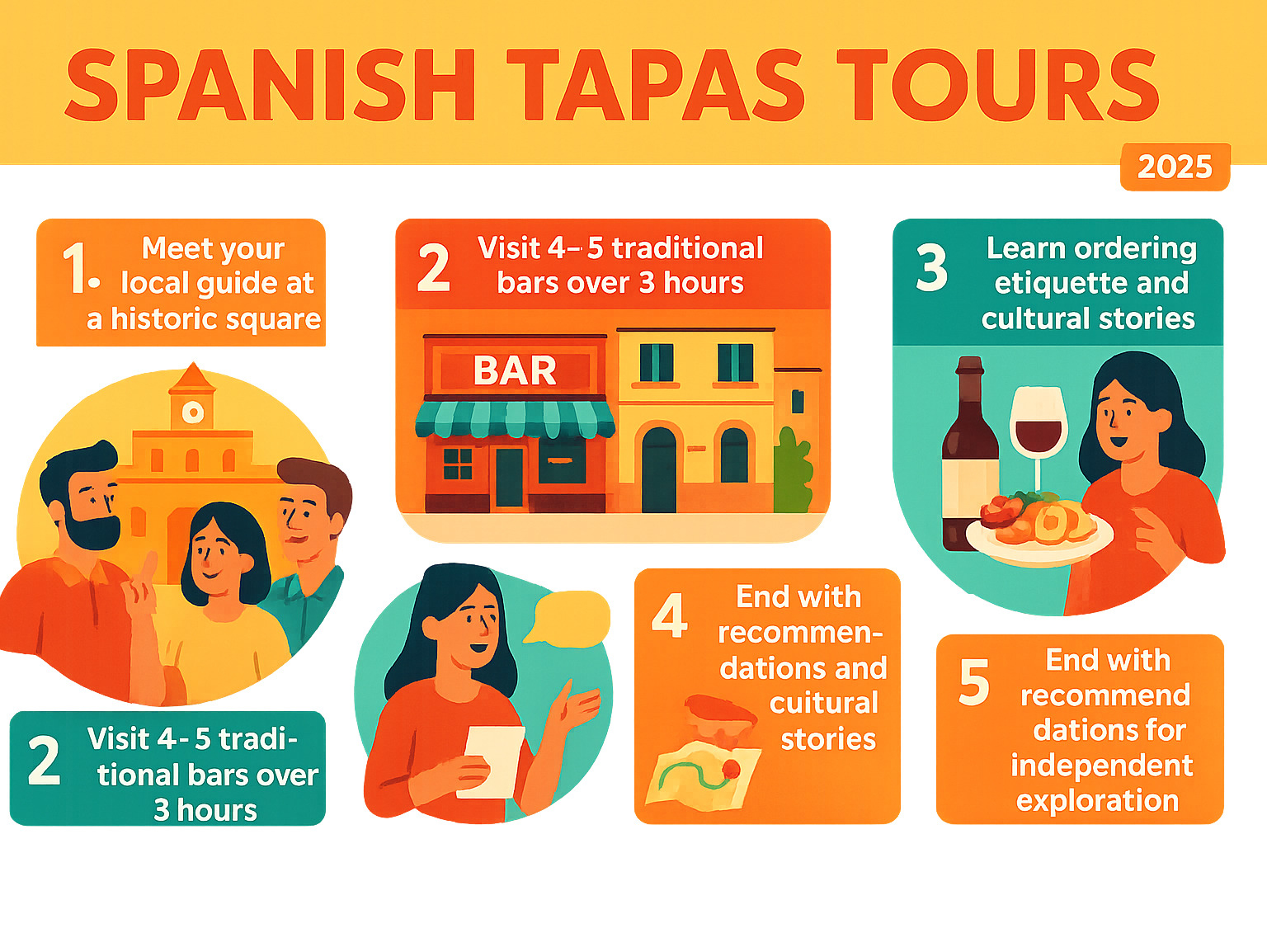
Relevant articles related to Spanish tapas tours:
Tapas 101: What, Why & How They Began
Picture this: you’re standing in a busy Spanish bar, surrounded by animated conversations and the gentle clink of glasses. The bartender slides a small plate of olives across the marble counter with your wine. You’ve just experienced the heart of Spanish culture – and it all started with a simple need to keep flies out of drinks.
Spanish tapas tours reveal this fascinating story as you hop from bar to bar, but understanding the deeper cultural significance makes every bite more meaningful. Tapas culture runs so deep in Spanish identity that UNESCO recognized it as Intangible Cultural Heritage of Humanity. It’s not just about the food – it’s about a way of life that has shaped how Spaniards connect with each other for centuries.
Bite-Size History
The most beloved origin story takes us back to 13th-century Spain and King Alfonso X of Castile. Legend says he ordered taverns to serve small snacks with wine to prevent his soldiers from getting too drunk. Whether this royal decree actually happened is debatable, but it makes for a great story your tour guide will likely share.
Another charming tale involves King Alfonso XIII centuries later, stopping at a tavern in Cádiz. The clever bartender covered the king’s sherry with a slice of jamón to protect it from the coastal sand and pesky flies. The king loved the idea so much that he ordered another drink “with the cover” – con la tapa.
The word “tapa” comes from the Spanish verb tapar, meaning “to cover.” This simple etymology tells the whole story – these weren’t fancy appetizers but practical solutions to real problems. Hot Andalusian weather, outdoor drinking, and flying insects made covered beverages essential.
Archaeological evidence points to Seville as the birthplace of tapas culture. From these southern Spanish roots, the tradition spread northward, adapting to local ingredients and customs. Each region put its own spin on the concept, creating the diverse tapas landscape we see today.
Tapas Culture Today
Walk into any authentic Spanish bar today, and you’ll notice something interesting – most locals are standing at the bar, not sitting at tables. This isn’t just about limited seating; it’s about fostering conversation and community. Standing encourages mingling, making it easier to chat with strangers and friends alike.
The magic happens in the movement between bars, a practice called “picoteo” (literally “pecking”). You’ll sample jamón ibérico at one spot, move to another for gambas al ajillo, then finish with croquetas somewhere else. Each bar has its specialty, and locals know exactly where to find the best version of their favorite tapas.
Some regions still honor the original tradition of complimentary tapas with every drink order. In Granada, you might receive a small plate of local cheese with your beer, while in León, the free tapa might be a hearty stew. This generous custom delights first-time visitors and keeps the social aspect of drinking alive.
Modern tapas have evolved into various regional formats. The Basque country perfected pinchos – elaborate small plates often secured with toothpicks. Andalucía developed montaditos – open-faced sandwiches on crusty bread. Throughout Spain, tostas provide a canvas for creative toppings.
Today’s tapas culture maintains its essential social function while adapting to contemporary tastes. The sharing aspect remains central – passing plates around the table, trying a bit of everything, and finding new flavors together. It’s this spirit of sharing and exploration that makes tapas tours such an authentic way to experience Spanish culture.
Must-Try Bites on Spanish Tapas Tours
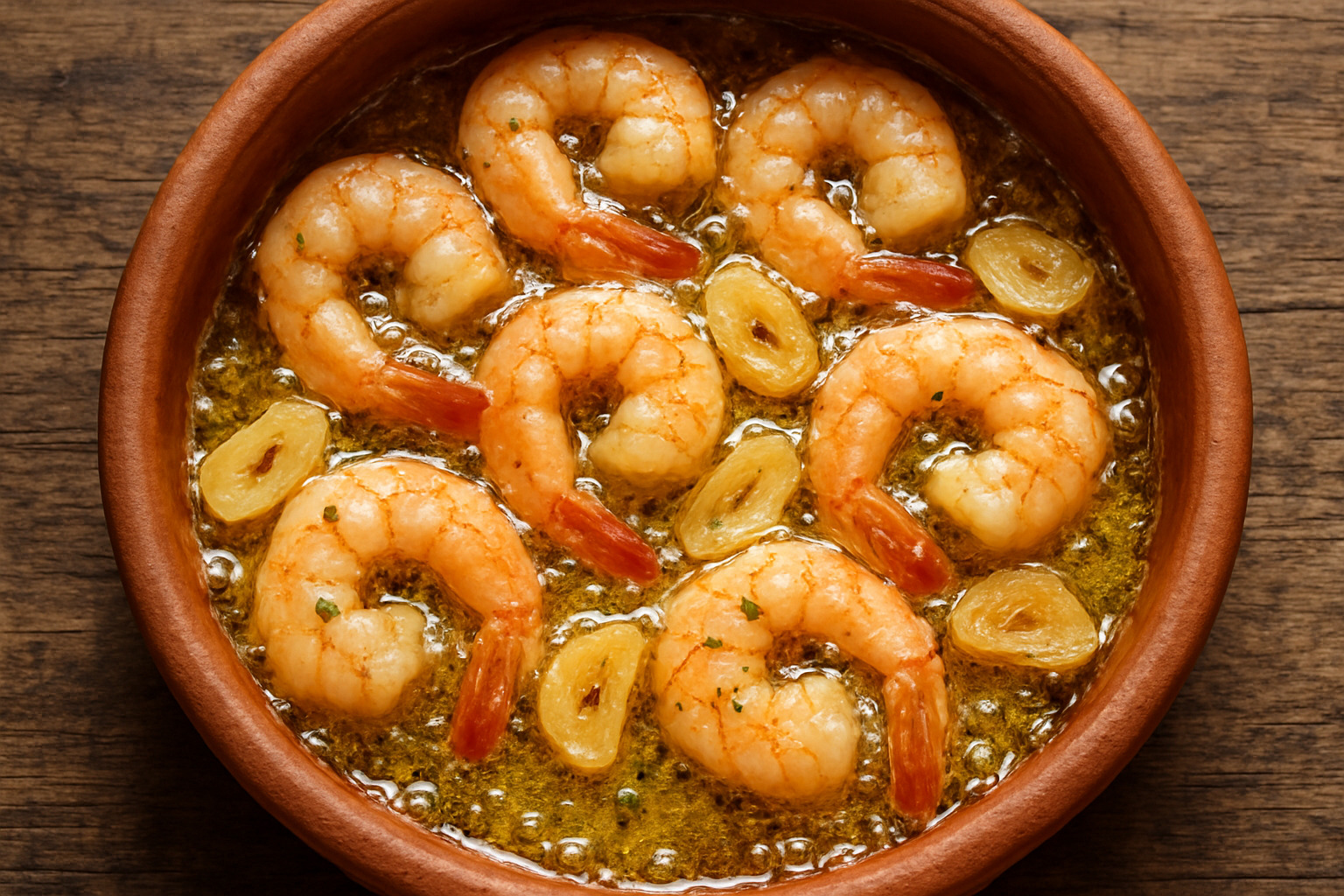
Picture this: you’re standing in a busy Spanish bar, the air thick with the aroma of garlic and olive oil, watching plates of golden croquetas disappear as quickly as they arrive. This is where Spanish tapas tours truly shine – introducing you to the iconic bites that have made Spain a global food destination.
Your taste buds are in for a treat. From the moment you take your first bite of paper-thin jamón ibérico to the last spoonful of creamy tortilla española, each dish tells a story about Spanish culture, history, and the art of turning simple ingredients into something magical.
Classics You’ll Meet Again & Again
Jamón ibérico will likely be your first introduction to Spanish excellence. This isn’t just ham – it’s a masterpiece that takes up to four years to create. The pigs roam oak forests, munching on acorns that give the meat its distinctive nutty flavor. When sliced paper-thin and served at room temperature, it literally melts on your tongue. Your tour guide will probably explain the difference between jamón serrano and the premium jamón ibérico de bellota, and trust us, you’ll taste the difference immediately.
Patatas bravas might look simple, but they’re anything but basic. These crispy potato cubes come topped with a spicy tomato sauce that varies dramatically from city to city. Madrid’s version packs heat with alioli on the side, while Barcelona adds smoky paprika that transforms the entire dish. Every bar guards their “brava” sauce recipe like a state secret.
The sizzle of gambas al ajillo arriving at your table is pure theater. These garlic shrimp come bubbling in clay dishes so hot they’re still cooking when they reach you. The magic happens when you soak up that golden, aromatic oil with crusty bread – a technique every local has mastered and every tourist must learn.
Tortilla española sparks more passionate debates than Spanish politics. This thick potato omelet should be creamy in the center, with eggs that are just barely set. Some regions add onions, others consider this heresy. Your guide will likely have strong opinions about which version is “authentic,” and honestly, that’s half the fun.
Croquetas represent Spanish comfort food at its finest. These golden cylinders hide a molten béchamel center studded with jamón serrano. The contrast between the crispy exterior and creamy interior makes them disappear faster than you can say “una más, por favor.”
Pintxo Gilda might look simple – just an anchovy, olive, and pickled pepper on a toothpick – but it’s perfectly balanced. Named after Rita Hayworth’s character in the 1946 film “Gilda,” this Basque creation is salty, briny, and slightly spicy all at once.
Seasonal & Regional Specialties
Spain’s regional diversity shines through seasonal specialties that change with the calendar and geography. In Catalunya, spring means calçots – sweet onions grilled over vine cuttings and dipped in romesco sauce. The ritual of eating calçots is so beloved that entire festivals celebrate their arrival.
The Basque country lifts seafood to an art form with txangurro – spider crab preparations that showcase why San Sebastián has more Michelin stars per capita than anywhere else. These aren’t your typical bar snacks; they’re sophisticated bites that happen to be served in casual pintxo bars.
Andalucía’s warm climate gave birth to salmorejo, a thick, cold soup that’s like gazpacho’s richer cousin. Made with tomatoes, bread, and olive oil, then topped with hard-boiled egg and jamón, it’s refreshing perfection in a bowl.
Vermut (Spanish vermouth) deserves special mention as the perfect tapas companion. This aromatic fortified wine has experienced a major comeback, especially as an afternoon aperitif paired with olives, anchovies, and good conversation. Many tours now include vermut tastings alongside regional wines from Rioja, Ribera del Duero, or Rías Baixas.
Each bite on your Spanish tapas tours connects you to centuries of culinary tradition, regional pride, and the Spanish philosophy that the best meals are shared with others. These aren’t just snacks – they’re edible stories waiting to be finded.
Spanish Tapas Tours by Region: Madrid, Barcelona, Seville & San Sebastián
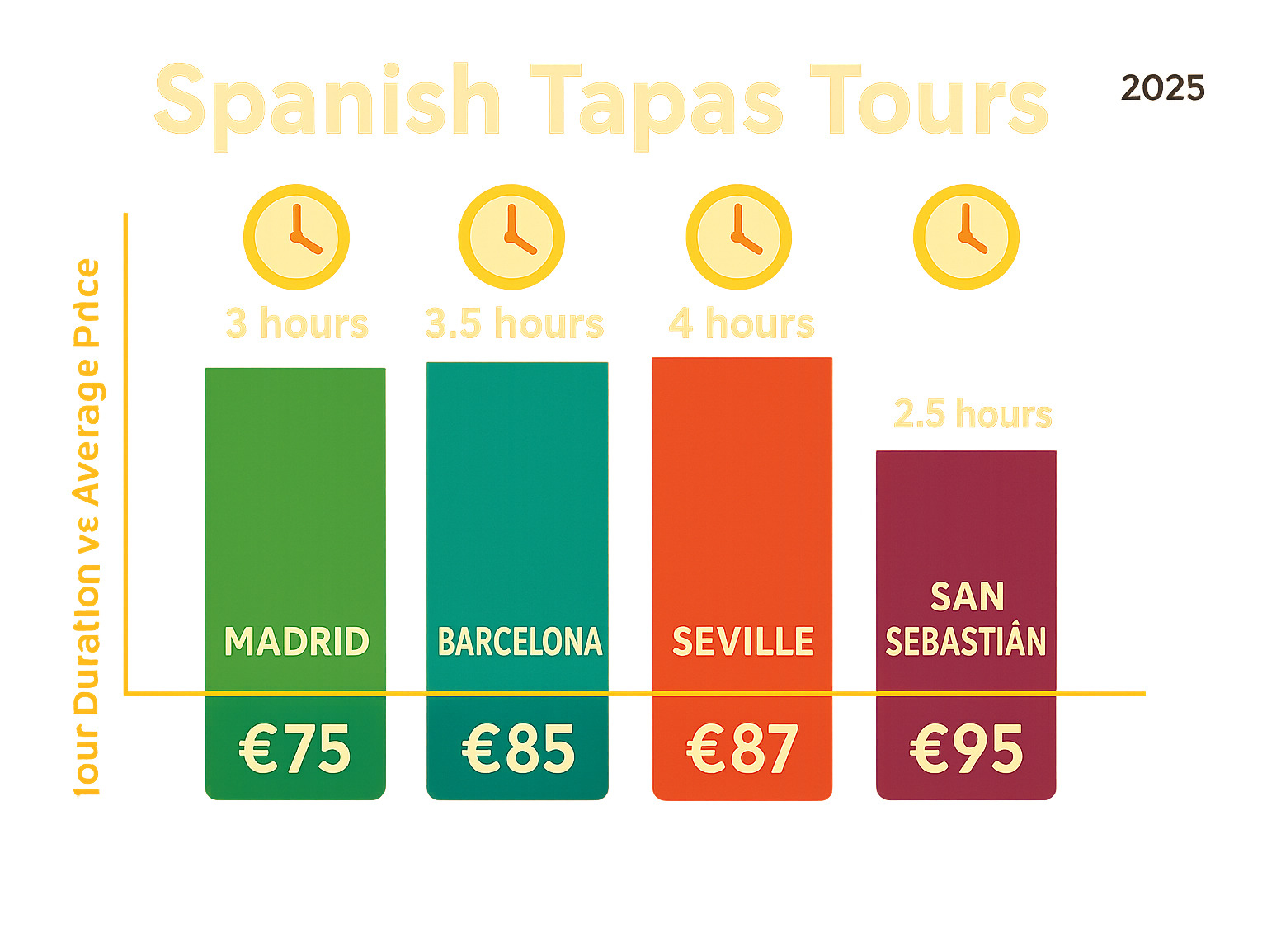
Each Spanish city tells its own delicious story through tapas, and the beauty lies in finding how local history shapes what ends up on your plate. From Madrid’s literary taverns to San Sebastián’s artistic pintxos, Spanish tapas tours reveal the personality of each destination through its food culture.
The regional differences go far beyond ingredients – they reflect centuries of cultural exchange, local traditions, and even climate influences. What you’ll taste in a Granada bar differs dramatically from a Barcelona bodega, and understanding these distinctions makes each tour feel like a mini cultural immersion.
Spanish Tapas Tours: Central Hotspots (Madrid & Toledo)
Madrid’s Spanish tapas tours feel like stepping into a living history book. The capital’s tours wind through La Latina’s cobblestone streets and the literary quarter around Santa Ana Square, where writers like Hemingway once held court over glasses of vermouth.
These tours celebrate Madrid’s vermut hour – that magical pre-lunch tradition where locals gather for Spanish vermouth paired with olives and anchovies. Your guide will explain why madrileños take this ritual so seriously, and you’ll quickly understand the appeal of this civilized approach to afternoon socializing.
The city’s historic taverns have served generations of families, and many still display the same hand-painted tiles and wooden bars from decades past. Tours often include stops at Mercado San Miguel, where traditional market culture meets modern tapas innovation under beautiful iron and glass architecture.
What makes Madrid tours special is the storytelling. Guides share tales of how the city evolved from a Moorish settlement to Spain’s cultural heart, explaining why certain dishes pair with specific drinks and the unwritten social rules that govern Spanish bar culture.
Pricing ranges from €74.90 to €145 per person, with private tours accommodating 2-6 people for those wanting a more personalized experience or specific dietary accommodations.
Spanish Tapas Tours: Coastal & Basque Gems (Barcelona, Malaga, San Sebastián)
Barcelona’s tapas scene blends Catalan pride with Spanish tradition, creating something uniquely Mediterranean. Tours here explore the Gothic Quarter and El Born, where medieval streets hide centuries-old bodegas that feel like secret findies.
You’ll learn to prepare pan con tomate the Catalan way – rubbing ripe tomatoes directly onto crusty bread before drizzling with olive oil. It sounds simple, but locals will judge your technique, so pay attention to your guide’s demonstration.
La Boqueria market often features on Barcelona tours, where vendors offer samples of local cheeses, cured meats, and seasonal produce. The city’s position between mountains and sea creates incredible ingredient diversity that influences every tapas preparation.
San Sebastián represents Spanish gastronomy at its most refined. Here, pintxos (the Basque version of tapas) reach artistic heights that challenge your assumptions about bar food. The old town concentrates dozens of pintxo bars within walking distance, perfect for the local practice of “poteo” – hopping from bar to bar while standing at counters.
What’s remarkable about San Sebastián is how seriously locals take their food culture. Don’t be surprised if fellow diners critique the chef’s technique or debate the merits of different preparations – it’s all part of the passionate food culture.
Malaga’s coastal location brings fresh seafood preparations and Andalusian specialties like boquerones (white anchovies) to the forefront. The city’s year-round mild climate makes outdoor tapas crawling particularly pleasant, with many tours extending into evening hours.
Spanish Tapas Tours: Southern Flavors (Seville & Granada)
Seville proudly claims to be tapas culture’s birthplace, and tours here feel like pilgrimages to the source. The city’s tours emphasize this historical significance while showcasing orange wine and traditional Andalusian preparations that reveal centuries of Moorish influence.
The southern Spanish approach to tapas feels more generous and relaxed than northern counterparts. Portions tend to be larger, conversations longer, and the overall pace more leisurely – reflecting the region’s warm climate and laid-back lifestyle.
Granada maintains something magical that’s disappeared from most Spanish cities: the tradition of free tapas with drink orders. This generous custom makes Granada tours unique, as you’ll experience authentic local hospitality that hasn’t been commercialized.
Some southern tours incorporate flamenco culture, combining tapas crawling with intimate flamenco performances in traditional tabernas. The region’s warm evenings encourage outdoor dining, creating a festive atmosphere that improves the social aspects of tapas culture.
The Moorish architectural backdrop adds drama to the dining experience. Eating tapas in courtyards surrounded by centuries-old tiles and fountains creates memories that extend far beyond the food itself.
How to Pick the Perfect Tapas Tour
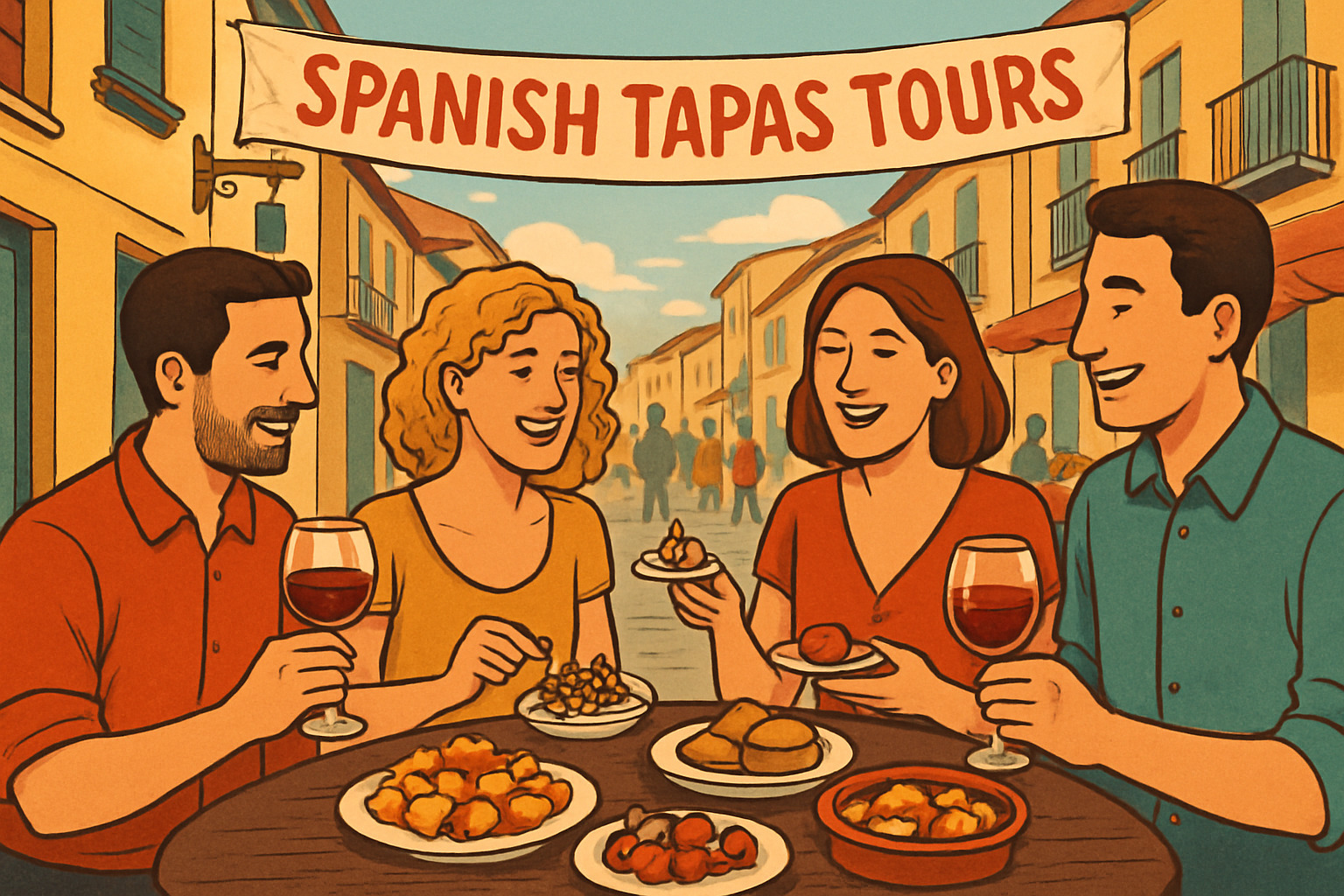
Choosing the perfect Spanish tapas tour doesn’t have to feel overwhelming, even with prices ranging from €55 to €128 and durations spanning 2.5 to 4 hours. The key is understanding what matters most to you – whether that’s intimate access to hidden gems, meeting fellow travelers, or having complete control over your experience.
Think about how you like to travel. Do you prefer having a guide’s undivided attention, or do you enjoy the energy that comes from exploring with other curious food lovers? Your answer will help determine whether a private or group tour suits you better.
Matching Tour Types to Traveler Styles
Private tours offer the ultimate personalized experience, accommodating 1-8 people with pricing from €355 for solo triprs up to €940 for groups of eight. These tours adapt completely to your rhythm – if you want to linger over that perfect jamón ibérico or skip the seafood due to allergies, your guide adjusts accordingly.
Couples often gravitate toward private experiences for the romantic intimacy of finding hidden bodegas together. Families appreciate the flexibility to accommodate children’s schedules and dietary needs without feeling rushed or apologetic.
Small group tours strike a wonderful balance between personalization and social energy. With 10-20 participants maximum and costs typically between €69-€95 per person, these tours create natural opportunities for conversation while maintaining the guide’s ability to share detailed cultural insights.
Solo travelers particularly love small group formats – you’ll often find yourself chatting with fellow food enthusiasts from around the world while learning local ordering customs. The shared findy of an exceptional tortilla española or perfectly paired Rioja creates instant connections.
Corporate events transform team-building from awkward icebreakers into genuine cultural immersion. Tour operators customize these experiences for larger groups, sometimes incorporating cooking workshops or wine education alongside the traditional bar-hopping format.
The consistently high ratings speak volumes – most operators maintain 4.8 stars and above, with 97-100% of participants recommending the experience. This reflects both the quality of local guides and the carefully curated selection of authentic venues.
Booking & Budget Hacks
Smart booking starts with understanding the flexibility most operators offer. Free cancellation up to 24-48 hours in advance protects your plans, while “reserve now, pay later” options let you secure popular time slots without immediate payment. The system automatically bills you 2 days before your tour, giving you time to finalize your travel plans.
Advanced reservations become essential during peak tourist seasons and for highly-rated tours that consistently sell out. Weekend evening tours draw the biggest crowds, so consider weekday afternoons for better availability and sometimes more relaxed local atmospheres.
Walking distance varies significantly between tours – some cover compact historic neighborhoods while others span several kilometers. Check the route details if mobility is a concern, and don’t hesitate to ask operators about the physical demands.
Dietary accommodations are increasingly common, with most operators handling vegetarian, gluten-free, and allergy-sensitive requests when notified in advance. The more specific information you provide during booking, the better your guide can customize the experience.
Tipping etiquette follows the standard 10-15% guideline for exceptional service, though some tours include gratuities in the base price. When in doubt, ask your guide or follow the lead of other participants.
Group discounts sometimes apply for parties of six or more, and repeat customers occasionally receive special pricing. Corporate bookings often open up additional customization options and preferential rates.
More info about Guided Food Tours
Pro Tips, Etiquette & Insider Experiences
Mastering the art of Spanish bar culture transforms your Spanish tapas tours from mere sightseeing into authentic local experiences. The difference between tourists and temporary locals often comes down to understanding subtle social cues and time-honored traditions that Spanish diners take for granted.
Timing is everything in Spanish tapas culture. Locals gather for lunch tapas between 1-3 PM, when bars offer their daily specials alongside traditional favorites. Evening sessions run from 8-11 PM, creating a lively atmosphere that builds toward dinner. Arriving outside these windows means missing the authentic social buzz that makes tapas culture so special.
Standing at the bar rather than seeking tables immediately marks you as someone who understands Spanish customs. This positioning encourages conversation with bartenders and fellow diners, often leading to recommendations for the best dishes or nearby bars worth visiting. The bar area is where locals gather, creating the social energy that defines authentic tapas experiences.
The one drink per bar tradition keeps you moving through neighborhoods while respecting each establishment’s hospitality. Order “una caña” (small draft beer) for casual afternoon visits, or try the house vermut (vermouth) during evening crawls. Each bar typically offers a signature drink that complements their tapas specialties, so don’t hesitate to ask for recommendations.
Splitting the bill equally among your group reflects Spanish communal dining values. Rather than calculating individual consumption, locals divide the total cost evenly – a practice that reinforces the social nature of shared meals. This approach eliminates awkward payment discussions and keeps the focus on conversation and connection.
Learning key phrases like “¿Qué nos recomienda?” (What do you recommend?) and “¡Está buenísimo!” (It’s delicious!) shows respect for local culture and often results in better service. Bartenders appreciate when visitors make an effort to engage in Spanish, frequently responding with extra attention or special recommendations.
Scientific research on eating tapas like a local confirms that authentic experiences require understanding social customs beyond just food preferences.
Unique & Themed Tapas Trips
Wine-focused tours lift traditional tapas experiences by pairing each dish with carefully selected Spanish wines from different regions. These specialized tours appeal to wine enthusiasts who want to understand how Spanish viticulture complements local cuisine, often including tastings from prestigious Denominación de Origen regions like Rioja and Ribera del Duero.
Real Madrid stadium plus tapas combinations attract football fans seeking to explore Spanish sports culture alongside culinary traditions. These unique tours typically include museum visits followed by tapas in nearby traditional bars frequented by local supporters, creating an authentic connection between Spain’s two great passions.
E-bike tours with cava offer active exploration of cities like Barcelona, combining cycling with stops at traditional bodegas for sparkling wine and tapas pairings. These tours cover more ground than walking tours while maintaining the social aspects of traditional tapas crawling, perfect for travelers who want to see more of the city.
Motorcycle sidecar crawls provide unforgettable transportation between tapas stops, appealing to trip-seeking travelers who want Instagram-worthy experiences alongside authentic food culture. These tours offer a unique perspective on Spanish cities while maintaining focus on traditional culinary experiences.
Street-Food Tours offer related experiences for travelers interested in casual dining cultures worldwide.
Frequently Asked Questions about Spanish Tapas Tours
What’s included in the average tapas tour price?
When you book Spanish tapas tours, you’re getting remarkable value packed into one experience. Your tour price covers a knowledgeable local guide who speaks English fluently and knows the best-kept secrets of their city’s food scene. You’ll sample 10-12 different tapas across 4-5 carefully chosen establishments, plus enjoy 4-5 alcoholic beverages perfectly paired with your food.
The beauty of these tours lies in their all-inclusive nature. Once you’ve paid, you can simply enjoy yourself without fumbling for euros at each stop. Your guide handles all the ordering and payments, letting you focus on savoring each bite and soaking up the atmosphere.
Most tours involve pleasant walks of 5-10 minutes between venues, giving you time to explore historic neighborhoods and work up an appetite. Some operators include hotel pickup and drop-off if you’re staying in central areas, though this varies by company.
Gratuities can be tricky territory. Some group tours include tips in the total price, while private tours often leave tipping to your discretion. Always ask about tipping policies when booking to avoid any awkward moments later.
Can vegetarians, gluten-free or allergy-sensitive travelers join?
Vegetarian travelers will find plenty to love on Spanish tapas tours. Spain’s cuisine naturally includes many meat-free options like tortilla española, pimientos de padrón, and various cheese and vegetable preparations. Most tour operators happily accommodate vegetarian requirements with advance notice.
Gluten-free dining presents more challenges, since many traditional tapas involve bread or wheat-based preparations. However, experienced operators can usually arrange alternatives. Your options might be more limited than the standard menu, but you won’t go hungry.
Severe allergies require honest conversation with tour operators before booking. Some companies require signed waivers for participants with serious food allergies, and not all can guarantee complete allergen avoidance in traditional bar environments where cross-contamination might occur.
Vegan requirements are the toughest to accommodate, as Spanish tapas culture heavily features animal products. Some operators offer specialized vegan tours, while others simply cannot adequately serve plant-based diners. Be upfront about your needs when booking.
What time of day is best for a tapas crawl?
Evening tours running from 6-9 PM offer the most authentic Spanish experience. This timing aligns perfectly with traditional Spanish dining schedules when bars come alive with locals socializing after work. You’ll find the full range of tapas options available and experience the true spirit of Spanish nightlife.
Afternoon tours from 2-5 PM work wonderfully for travelers who prefer earlier dining or want to experience Spanish “siesta” culture. These tours often feature vermut (vermouth) tastings and lighter fare, perfect for those adjusting to Spanish time zones.
Lunchtime tours between 12-3 PM showcase how Spaniards approach midday dining. You’ll enjoy heartier tapas that often substitute for traditional lunch courses, making these tours ideal for travelers maintaining earlier meal schedules.
Weekend evening tours offer the most festive atmosphere but require advance booking due to their popularity. Weekday tours provide more intimate experiences with locals and better availability at popular venues, plus you’ll often get more personalized attention from your guide.
Conclusion
Here at The Dining Destination, we believe every traveler deserves to experience Spain like a local – and Spanish tapas tours are your golden ticket to authentic Spanish culture. These aren’t just food tours; they’re your passport to understanding how Spaniards truly live, laugh, and connect over shared plates.
Think about it: where else can you find centuries-old traditions while nibbling jamón ibérico in a tavern that’s been family-owned for five generations? From Madrid’s literary quarter to San Sebastián’s pintxo paradise, these tours open up doors that most tourists never even notice.
The magic happens in those moments between bites. When your guide explains why locals always stand at the bar, or when you successfully order “una caña” and the bartender nods approvingly – that’s when you transform from tourist to temporary local. Our research shows that Spanish tapas tours consistently earn those stellar 4.8+ star ratings because they deliver exactly this kind of authentic connection.
Your investment of €55-€128 per person pays for itself in ways you might not expect. You’ll taste incredible food and wine, but you’ll also learn the social codes that make every future Spanish dining experience richer. You’ll know which neighborhoods hide the best kept secrets, how to read a Spanish menu with confidence, and why sharing food is considered the highest form of hospitality.
The beauty of tapas culture lies in its simplicity – good food, good wine, good company. But accessing the real deal requires insider knowledge that only comes from years of local experience. That’s exactly what these carefully curated tours provide, complete with passionate guides who’ve spent their lives perfecting the art of Spanish hospitality.
Don’t wait to book your culinary trip. The most popular Spanish tapas tours fill up weeks in advance, especially during peak travel seasons. Whether you’re dreaming of romantic Barcelona bodegas or festive Seville tabernas, your perfect Spanish food story is waiting to unfold.
More info about travel-for-food packages
Ready to become a true “tapa-trooper”? Spain is calling, and trust us – you’re going to want to answer. ¡Buen provecho!

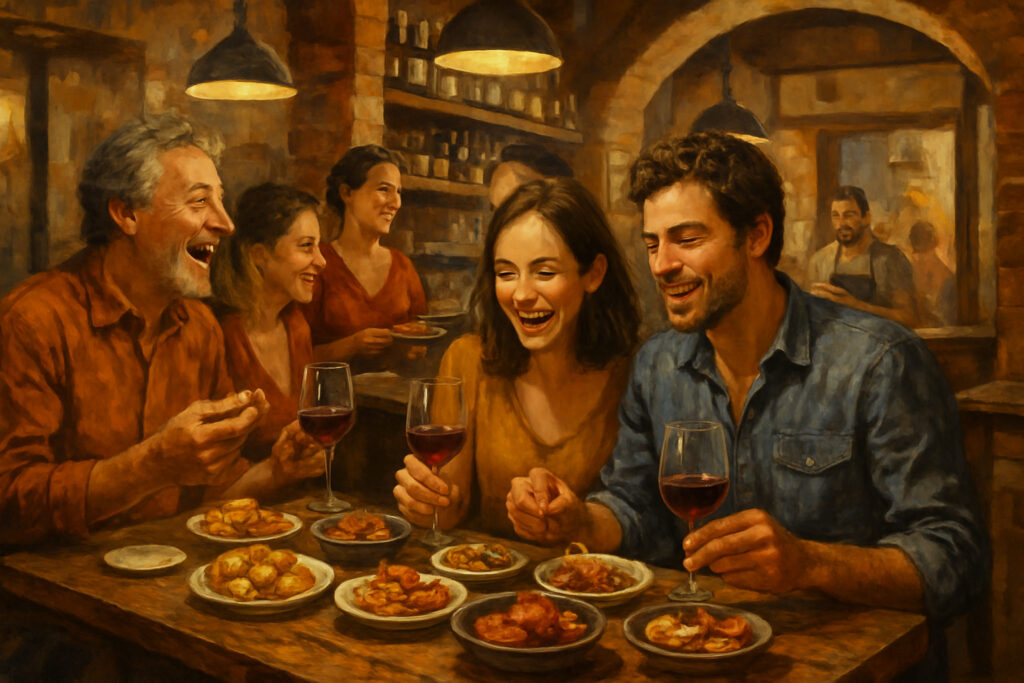






1 thought on “Tapas Tours That’ll Make You Say Olé!”
Pingback: From Bland to Grand – Food Photography Workshops Worth Traveling For - The Dining Destination
Comments are closed.